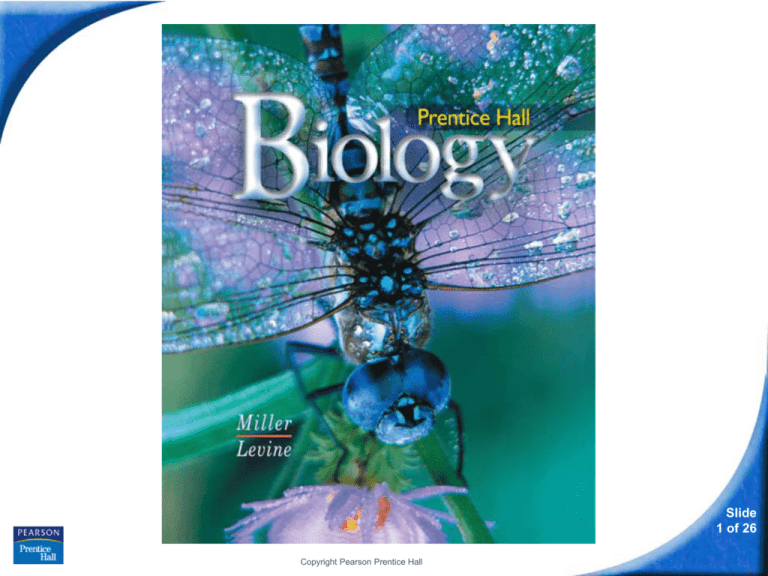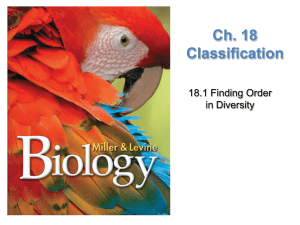
Biology
Slide
1 of 26
Copyright Pearson Prentice Hall
18-1 Finding Order in
Diversity
Slide
2 of 26
Copyright Pearson Prentice Hall
18-1 Finding Order in Diversity
Why Classify?
To study the diversity of life, biologists
use a classification system to name
organisms and group them in a logical
manner.
Slide
3 of 26
Copyright Pearson Prentice Hall
18-1 Finding Order in Diversity
Why Classify?
In the discipline of taxonomy, scientists classify
organisms and assign each organism a universally
accepted name.
a. Two names
b. First name capitalized, second not
c. Italicized or underlined
d. Latin
Slide
4 of 26
Copyright Pearson Prentice Hall
18-1 Finding Order in Diversity
Assigning Scientific Names
Carolus Linneaus developed a naming system
called binomial nomenclature.
In binomial nomenclature, each species is
assigned a two-part scientific name.
Slide
5 of 26
Copyright Pearson Prentice Hall
18-1 Finding Order in Diversity
Assigning Scientific Names
The first part of the name is the genus to which the
organism belongs. A genus is a group of closely
related species. The genus name is capitalized.
The second part of the name is unique to each
species within the genus. This part of the name often
describes an important trait or where the organism
lives. The species name is lowercased.
Slide
6 of 26
Copyright Pearson Prentice Hall
18-1 Finding Order in Diversity
Linnaeus's System of
Classification
Linnaeus's seven levels of classification
are—from smallest to largest—
• species
• genus
• family
• order
• class
• phylum
• kingdom
Slide
7 of 26
Copyright Pearson Prentice Hall
18-1 Finding Order in Diversity
Linnaeus's System of
Classification
Each level is called a taxon, or taxonomic category.
Species and genus are the two smallest categories.
Grizzly
bear
Black
bear
Slide
8 of 26
Copyright Pearson Prentice Hall
18-1 Finding Order in Diversity
Linnaeus's System of
Classification
Genera that share many characteristics are grouped
in a larger category, the family.
Grizzly
bear
Black
bear
Giant
panda
Slide
9 of 26
Copyright Pearson Prentice Hall
18-1 Finding Order in Diversity
Linnaeus's System of
Classification
An order is a broad category composed of similar
families.
Grizzly
bear
Black
bear
Giant
panda
Red
fox
Slide
10 of 26
Copyright Pearson Prentice Hall
18-1 Finding Order in Diversity
Linnaeus's System of
Classification
The next larger category, the class, is composed of
similar orders.
Grizzly
bear
Black
bear
Giant
panda
Red
fox
Abert
squirrel
Class Mammalia
Slide
11 of 26
Copyright Pearson Prentice Hall
18-1 Finding Order in Diversity
Linnaeus's System of
Classification
Several different classes make up a phylum.
Grizzly
bear
Black
bear
Giant
panda
PHYLUM
Red
fox
Abert
squirrel
Coral
snake
Chordata
Slide
12 of 26
Copyright Pearson Prentice Hall
18-1 Finding Order in Diversity
Linnaeus's System of
Classification
The kingdom is the largest and most inclusive of
Linnaeus's taxonomic categories.
Grizzly
bear
Black
bear
Giant
panda
Red
fox
Abert
squirrel
Coral
snake
Sea
star
KINGDOM Animalia
Slide
13 of 26
Copyright Pearson Prentice Hall
18-1 Finding Order in Diversity
Grizzly Black Giant
bear
bear panda
Linnaeus's System of
Classification
Coral Sea
Red Abert
fox squirrel snake star
Slide
14 of 26
Copyright Pearson Prentice Hall
18-1
Click to Launch:
Continue to:
- or -
Slide
15 of 26
Copyright Pearson Prentice Hall
18-1
Which statement about classification is true?
a. Biologists use regional names for organisms.
b. Biologists use a common classification
system based on similarities that have
scientific significance.
c. Biologists have identified and named most
species found on Earth.
d. Taxonomy uses a combination of common
and scientific names to make the system
more useful.
Copyright Pearson Prentice Hall
Slide
16 of 26
18-1
Linnaeus's two-word naming system is called
a. binomial nomenclature.
b. taxonomy.
c. trinomial nomenclature.
d. classification.
Slide
17 of 26
Copyright Pearson Prentice Hall
18-1
Several different classes make up a(an)
a. family.
b. species.
c. kingdom.
d. phylum.
Slide
18 of 26
Copyright Pearson Prentice Hall
18-1
A group of closely related species is a(an)
a. class.
b. genus.
c. family.
d. order.
Slide
19 of 26
Copyright Pearson Prentice Hall
18-1
Which of the following lists the terms in order
from the group with the most species to the
group with the least?
a. order, phylum, family, genus
b. family, genus, order, phylum
c. phylum, class, order, family
d. genus, family, order, phylum
Slide
20 of 26
Copyright Pearson Prentice Hall
END OF SECTION







